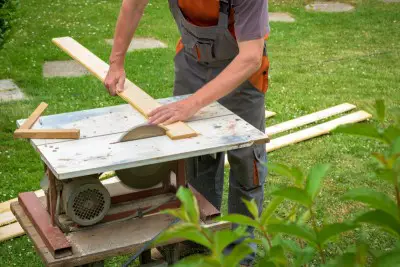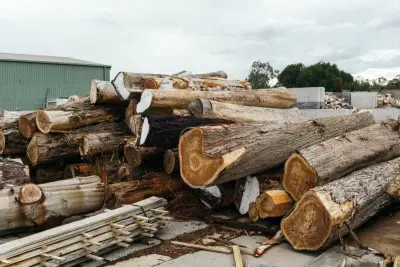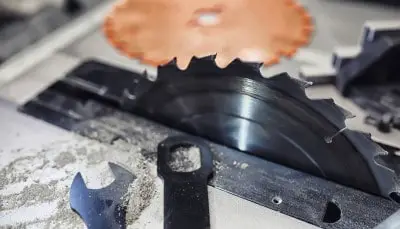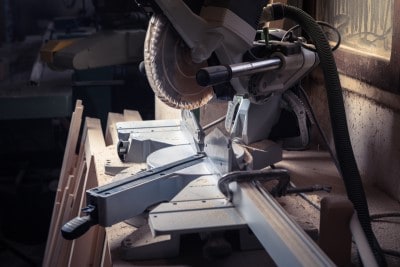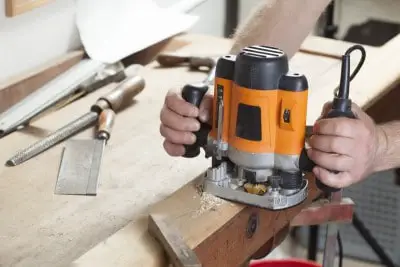Of all the electric saws, table saws are one of (if not the most) popular; you would be hard-pressed to find a serious woodworker without one in their arsenal of tools, and for good reason! Assuming the equipment is of good quality, the accuracy and precision cutting that the table saw is capable of is stellar.
The table saw is also prized for its versality; if your table saw is in good shape, this machine can cut anything from massive hunks of lumber to small pencil-sized slices of wood. The size of table saws can also vary greatly, ranging from lightweight and portable to big ktichen-table sized machines.
If you are a beginner woodworker, it is highly recommended to purchase a table saw; although you can get away with using other smaller tools, the versatility and performance of this saw allows for cutting all types of wood for all purposes.
The longer you work with wood and the more projects you take on, the more essential owning a table saw will be; it is a great first electric saw for any beginner who is ready to move on to the next level in their woodworking career. This may not be evident to you yet, but as time goes on and you get more experienced you will eventually require the use of a table saw.
In this article, we will first go over exactly why table saws are so important for beginner woodworkers; then, we will discuss the various downsides of table saws and the limitations of the tool and, finally, we will go over the basics of how to use a table saw.
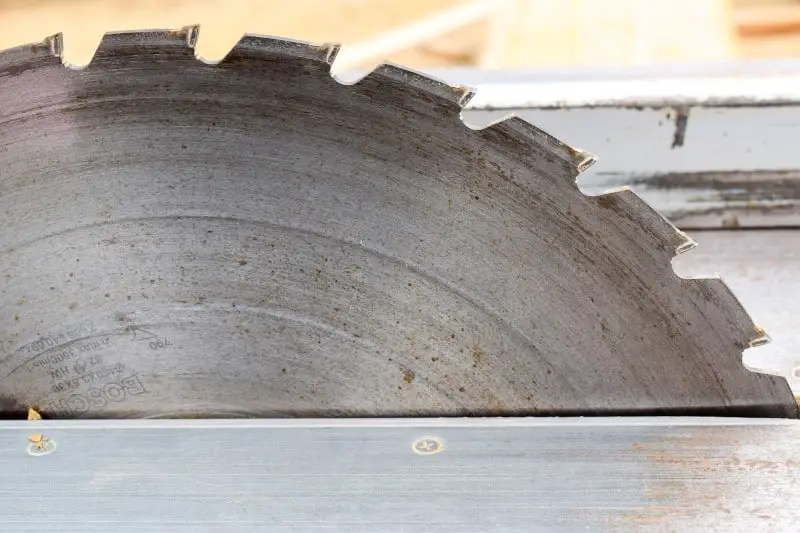
Why Table Saws Are Necessary For Beginners
As mentioned, table saws are arguably the most common electric saw for woodworkers everywhere; there are many reasons for this (which we will soon get into) but first, let me answer the question… why is it that table saws are a great tool for beginners, even compared to other electric saws?
The unique benefits of table saws include:
Cost
When you are first starting out as a woodworker, you will likely not want to spend thousands (or ten’s of thousands) on acquiring all of the different tools you can buy. As you know, woodworking equipment are expensive… this is especially true when it comes to electric saws.
A table saw is relatively inexpensive, going for anywhere from $250 to $2500 (obviously price will vary, and they can be much more expensive). While this certainly can be a lot for some people, most serious woodworkers have multiple power saws in their shop that can be worth thousands.
For a beginner woodworker, you do not need a set of power tools worth $10,000 or more. In fact, you can get away with only spending a few hundred dollars to start… you simply do not need a massive budget when you are only ‘getting your feet wet’ in the world of woodworking.
As mentioned, table saws can cost as little as a couple of hundred dollars; if you are just starting out as a woodworker, you do not need to fork out a bunch of money to get the best table saw on the market.
It is worth mentioning that table saws are more expensive than certain other electric saws; for example, circular saws generally cost more. That said, table saws are still less money than many other types of electric saw.
Another main reason table saws are a perfect electric saw for beginner woodworkers is because of the versatility of the tool.
Read more: Average Table Saw Cost
Versatility
The more advanced you get at your craft and the more experienced you become in the woodworking world, the more specific you will need your tools to be. When you are taking on project after project, sometimes you will need a certain tool to do a very specific task for you – this means you will require a whole arsenal of tools, all for different uses, so that you can get the best final result possible.
That said, if you are a beginner then you will not need to have every tool that money can buy – in fact, you can get away with purchasing a select few of tools that are able to substitute as others.
The table saw is an example of a tool that can do the job of many other electric saws… although it may not be as good at certain tasks as other saws, it is valuable since it can do almost everything quite well.
So, a table saw is perfect for beginners because it is so versatile; it can do lots of different jobs, and many different kinds of cuts.
This includes:
- rip cuts (this is a table saw’s main strength – this means ‘ripping’ your piece of wood lengthwise. If your table saw is big enough, it can handle any size cut you need, big or small).
- cross cuts (these are best done by a miter or chop saw, although the table saw can handle these just fine – this is simply the opposite of a rip cut, going against the grain of the wood).
- dado cuts (as long as you get a dado blade, this type of cut is possible with a table saw – a dado cut is a ‘trench’ or ‘slot’ cut made in your piece of wood so that another piece of wood can fit into it).
- rabbet cuts (this is a cut made on one of the sides or the end of a piece of wood, so that other pieces of wood can fit into it).
- bevel cuts (this is a slanted cut into a piece of wood that can be done with an angled blade on your table saw).
- miter cuts (with the use of a miter gauge, table saws can do this type of cut as well – basically, this is an angled cut that is made across the width of a piece of wood).
Remember, although the table saw can perform all of these different types of cuts, other saws will be better for certain cuts; but, since you are a beginner, this is not yet important.
The cost and versatility of table saws go hand in hand; the initial cost of this piece of equipment is much less than other power tools, and since it is so versatile in its ability, this means you can get away with only owning a table saw and not any other electric saws (at least until you become a more experienced woodworker).
Another reason the table saw is great for beginners is simply because it is easier to use than other electric saws.
Ease Of Use
Table saws are designed to be user friendly and, when compared to other electric saws, are quite easy to use.
Most models will make it a simple process to swap different blades out for one another – this is a feature you should look out for before purchasing a new table saw.
Not only should it be easy to change the blade, but many inexpensive table saws are also quite portable; in the case that you don’t invest in a big sturdy (and expensive) table saw, you will likely buy a model that makes it simple to ‘collapse’ the saw and move it to wherever you need to be.
Another way in which table saws are easy to use has to do with their ability to reach many different angles with the blade, moreso than many other types of electric saw.
All things considered, table saws are an ideal starter saw for woodworking beginners; now, let’s examine a few of the downsides of table saws.
Table Saw Downsides
Although the benefits of table saws far outweight the downsides, it is certainly worth taking a look at some of the shortcomings of this type of power tool.
The downsides of table saws include:
Size
The size of table saws can be seen as a major hindrance.
First of all, the larger size of table saws are typically what make them so sturdy; the accuracy and precision that this piece of equipment is known for has a lot to do with the fact that table saws are not hand-held. This makes it easier to cut wood and allows the woodworker to rely less on their own precision, and focus more on the cutting itself.
But, the size of table saws mean that they are not very portable.
You can buy portable table saws, and these are great options for beginners – however, just because they are sold as ‘portable’ does not mean they will be as easy to transport as other electric saws… like a chainsaw, for example.
This means that the only wood you can cut with a table saw is wood that can be placed on top of the surface of the table saw; any wood that is too heavy or too big to be brought into the area where your table saw is set up or wood that cannot physically be lifted onto the saws surface will simply not be able to be cut.
This is why other saws are preferred for certain circumstances; not all wood you need to cut with be light enough to lift onto a table saw surface. If you are a beginner, it might be a while until you have this problem but, the more experienced you get, the more variety of wood you will want to cut and therefore will need different types of electric saws.
Whether the size of table saws is a real problem is completely up to the woodworker.
The safety factor associated with table saws are also a huge concern for many beginner woodworkers.
Danger
Yes, table saws are inherently dangerous; the same is true for basically all electric saws, but they are actually more dangerous than circular saws, for example.
A moment of poor judgment can lead to a lost finger or worse; although some models have built-in safety features that will stop the blade if it comes into contact with human skin, this type of feature will only come with saws that are $1000+.
If you are worried about safety, then simply take your time to understand how to use a table saw properly.
Here is a quick overview of how to use a table saw if you are a beginner woodworker.
How To Use A Table Saw For Beginners (Step-by-Step)
This is meant to be a quick guide on how to make your first cut with a table saw.
Step 1: Safety Precautions
Put on safety glasses and analyze your table saw to check for any damage, wear or tear; make sure to examine the blade as this is (first and foremost) the part of your saw that is most dangerous to you and the people around you.
Step 2: Know Your Cut Type
Determine exactly what type of cut you are going to make.
Is it a crosscut? A ripping cut? A dado cut?
By knowing what cut you are about to do, you can set yourself up properly. Also, going into it ‘blind’ is dangerous and can result in damaged wood.
Step 3: Proper Blade
This is another simple step; are you using the right blade for the cut you are doing? If so, great – if not, replace the blade with the one you need for your cut.
Step 4: Set Blade Height
Now you must set the blade height.
To do this, you are going to want to set the blade about 1/8 inche higher than the size of your wood. This way, you are setting yourself up for safety in case you have an accident; the size difference between the blade height and your wood is basically how deep the blade will go in your skin if you mess up.
Step 5: Angle The Blade
This step is simple; depending on the type of cut your are doing, you must angle the blade accordingly.
Step 6: Adjust The Fence
The fence is what allows you to cut wood lengthwise accurately – it is controlled by a lever near the front of the saw.
To adjust this, you lift the lever and slide the fence; position your fence to its proper place and, by placing a hand on top of your fence, use the other hand to snap down the lever.
Step 7: Time For Action
Now, it is time to actually make the cut; as long as you followed all the proper procedures up to this point and you have everything aligned, this is simple.
Feed the saw to cut the wood, and do it fast – a beginner mistake is to feed the saw too slowly, which can result in woodburn.
Obviously, there are many different ways to feed the saw depending on the type of cut you are performing; this goes beyond the scope of this beginner guide, so make sure you know what you are doing before you start sawing.
Step 8: Maintenance
This is an ongoing responsibility of owning a table saw.
Proper care, handling, storage, and maintenance of your table saw will mean less replacements and a longer lifespan for your equipment; for more information on table saw maintenance, read more here.
All in all, a table saw is a fantastic piece of equipment and there is a reason why it is so popular in the world of woodworking; if you are a beginner in the space and want to take your skills to the next level, you cannot go wrong with purchasing a good table saw.
Read more:

